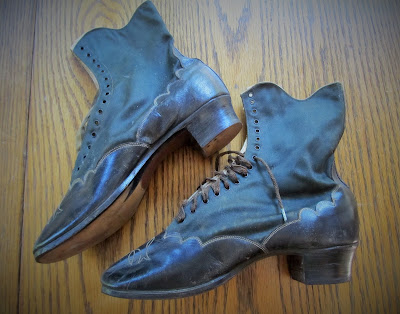To all of you that have followed Kelly's blog:
Kelly passed away on Sunday, July 10 after a long struggle with cancer. She was a beautiful lady that loved history, especially about clothing. A talented artist and great speaker at period history conferences. But most of all she was ecstatic to live on her island and be able to share her passion with you. She will be missed dearly for she has been my everything for 23 years. Sincerely,
Robin Dorman
The Balmoral boot was designed for Prince Albert as a walking boot. Albert was looking for a walking boot that he could both wear on the grouse moors of his Scottish estate Balmoral and which would look suitably stylish indoors as well.

The Balmoral boot was waterproofed to protect his feet from the wet gorse. Victoria also took a liking to the style and had several pairs made for herself, as she too liked to walk the grounds of Balmoral. With such distinguished wearers, it should come as no surprise that they became extremely popular with the gentry and later the general public alike. Apart from men, even women adapted Balmoral boots for daywear.
While made for an essentially rural setting, over time it began to be favored in urban areas as well; in those days the streets of major towns were quite dirty what with all the horse dung etc. lying around.
I purchased a pair of antique Blamorals and offered them for sale on my Etsy shop:
They have a number of lovely details, including scalloped tops and toe foxing, but I found one detail especially exciting:
They had never been worn!
I was (of course) pleased when they were purchased, but even more intrigued when I saw the name of the purchaser - Lauren Stowell of American Duchess.
And I was ecstatic when I saw this video on her website!
Unfortunately, I failed to post about this during the preorder sale, but her video alone is valuable - she outlines very well what to look for in a quality pair of reproduction Balmorals.
They have a number of lovely details, including scalloped tops and toe foxing, but I found one detail especially exciting:
They had never been worn!
I was (of course) pleased when they were purchased, but even more intrigued when I saw the name of the purchaser - Lauren Stowell of American Duchess.
And I was ecstatic when I saw this video on her website!
Unfortunately, I failed to post about this during the preorder sale, but her video alone is valuable - she outlines very well what to look for in a quality pair of reproduction Balmorals.


















